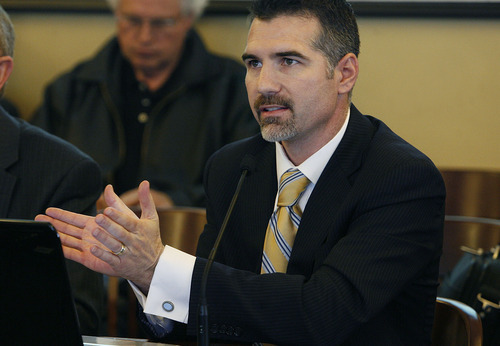This is an archived article that was published on sltrib.com in 2012, and information in the article may be outdated. It is provided only for personal research purposes and may not be reprinted.
Promoters of what would be Utah's first nuclear power plant are due to hear from the state this week whether they still have rights to water they need to cool the reactors — or if their plans face new scrutiny.
At least two groups insist State Engineer Kent Jones should step back from his initial decision last month to grant water rights to Blue Castle Holdings, the homegrown company that plans to develop a 3,000-megawatt plant near Green River. One reason, they say, is that Jones left too many questions unanswered about the finances for a project that is estimated to cost $100 million to $200 million just to license and up to $16 billion to build.
"We know very little" about the project funding, said environmental attorney Lara A. Swensen, who is representing some two dozen individuals and organizations opposed to the power plant.
"As the record stands, I don't think there's any reason to believe they can get adequate financing. It takes more than just your good word to get you there."
But that's essentially all it took to get the state's approval for rights to water — a resource as precious as gold in the West.
Not only is the state engineer's approval crucial for Blue Castle, but it also represents the only opportunity for residents to have their say on a state level before the plant's review is turned over to the federal government.
It also is the only time that Utah can weigh in on whether the project would be "speculative" and in violation of the law governing water.
Jones conceded the evidence he relied upon in granting the 53,600 acre-feet of Green River water was limited. But he said his hands are tied. The state doesn't require much, just the lowest standard of proof in the law: "a reason to believe."
Jones found that Blue Castle cleared that hurdle by providing him with pieces of information: a news release about an investment deal that never materialized, a small power utility's pledge of interest in the project, oral testimony given during a public hearing and a follow-up letter from an attorney representing the water district for Kane and San Juan counties. The water districts have potentially lucrative lease agreements with Blue Castle for their water.
—
Burden of proof • Consumers seeking a car or home loan would face a greater burden of proof — and would have to provide such documentation as pay stubs, credit reports and the like.
John Mann, assistant state engineer, declined to talk about the specifics of the Blue Castle case — his office is required to issue its decision before Thursday — but he noted the tentative financing schedule and funding plan met the "reason to believe" threshhold.
While some might contend that the company should have been required to meet a higher standard, Blue Castle president and CEO Aaron Tilton said his company followed the law to the letter.
"The argument is with the Legislature, or somewhere else, not with us," Tilton said. "We're certainly complying [with the law], and the state engineer has certainly met the regulatory hurdle" for approving the water rights.
He also dismissed the car- and mortgage-loan analogy.
"The state is not loaning money to anybody," he said. If the project is never completed, he added, the state hasn't lost anything.
Although state regulations give Jones the ability to ask for "such additional information as will enable him to guard the public interests," he never has. And Blue Castle never offered.
As Jones was considering Blue Castle's water-rights request, the last piece of information voluntarily provided was a June 2010 news release announcing a $30 million deal with LeadDog Capital, a company that now is in trouble with the U.S. Securities and Exchange Commission.
Since then, Blue Castle has pointed to its December 2010 acquisition of Willow Creek LLC, a Grand Junction, Colo., oil, gas and water pipeline construction and service company, as its main revenue source.
Like the collapse of the LeadDog Capital deal, Tilton never reported that development to the state. And even now, he is loath to share anything about how Blue Castle is getting the money that will be required to license the plant.
His companies are private, and he is not required to publicly disclose financial data.
But he and another top Blue Castle executive weren't so reticent previously.
—
Willow Creek revenues • In City Weekly last May, Tilton identified Willow Creek as a source of $30 million a year in revenue. And Blue Castle Chief Operating Officer Tom Retson wrote in the magazine Nuclear Energy International two months ago that Willow Creek was generating $27 million a year in revenue.
That clashes with information from Dun & Bradstreet, a well-known provider of business information, which puts Willow Creek's revenue at just $5.6 million a year.
Says Tilton: "Dun & Bradstreet doesn't know what they are talking about."
He insisted the Blue Castle subsidiary has a profit margin higher than average. In the pipeline service industry, that average is 4 percent to 9 percent for like-sized companies, according to the Risk Management Association, a nonprofit organization providing credit-risk information.
In other words, a company the approximate size of Willow Creek with $27 million in revenues would probably be generating a profit of around $2.5 million a year, a fraction of what Blue Castle estimates it will need each year to finance the licensing process.
The Tribune twice contacted Willow Creek and requested an opportunity to photograph one of its current projects. Both times the newspaper was referred back to Tilton, and he declined to give clearance for a photo. He said at one point he did not want to bother the company's clients.
In November 2010, another financing deal was announced, but it is one that Blue Castle has not discussed publicly, nor did it reveal the details to the state engineer.
A Canadian company called GRIT International sent out its own news release that it had "signed an agreement to financially participate in the Blue Castle Holdings Nuclear Project" that it said gives GRIT "a minority ownership stake."
Soon after, in a report to investors, GRIT said the "exit value" of its investment would be about $650 million in just a few years. It's worth pointing out that another GRIT news release a few months earlier described an infusion of $6.65 million in August 2010 from LeadDog Capital Markets.
If LeadDog sounds familiar, it's because that was the hedge fund that Blue Castle originally said it was going to rely on for $30 million. But last month, a week after the state engineer announced he was approving the water request for the nuclear plant, new information surfaced to suggest LeadDog is a sham, based on a cease-and-desist action filed in New York City by the SEC.
Tilton, who said only last month that Blue Castle never signed an agreement with LeadDog, said Friday that his company never signed an agreement with GRIT either.
—
Other financing • Still another key component of the financing plan that Blue Castle provided to the state was its strategy of lining up utilities and other investors who would sign up to participate in its project. They would provide needed capital in stages to help secure the licenses by 2016 and bring the plant online by 2021.
Blue Castle said it had signed a preliminary agreement with a "private equity fund" that had cash on hand and was ready to provide it with $50 million that was contingent upon it completing negotiations with multiple utilities for their participation in the project.
Tilton said Friday that financing arrangement also was not finalized.
But he insisted that numerous utilities have continued to express interest in the project, although none has been made public — except for one.
Page, Ariz., which operates its own municipal electric utility serving some 4,000 customers, acknowledged that it had signed an agreement of interest with Blue Castle. But even then, the Page city attorney has indicated there was "no financial obligation" involved.
Although Tilton said he approached the Utah Municipal Power Agency and the Utah Associated Municipal Power Systems about their interest, neither has jumped on board the nuclear project.
"They [Blue Castle] never asked us for anything — they just wanted us to know what they were doing," said Doug Hunter, the general manager of UAMPS, which represents 45 small, publicly owned utilities in Utah and several other nearby states.
He said the UAMPS board did raise the question of Blue Castle's financing and was told by Tilton that the company had adequate funding. "We just let it slide. They [developers of proposed power projects] are all going to say that."
Tilton says all this hoopla about the project's financing amounts to nothing. He points to the milestones Blue Castle has already achieved and insists that's how the company should be judged.
"The real issue is we're completing and doing everything critics say that we can't," said Tilton, citing as examples the securing of water rights and pre-licensing activities that are under way. "I don't know how you can argue against that."
steve@sltrib.com
fahys@sltrib.com
Twitter: judyfutah —
Due diligence
Utah law requires the state engineer, Utah's top water rights official, to certify that an applicant for a water rights change "has the financial ability to complete the proposed works."
The law also gives the person in that role added powers for scrutinizing an applicant's finances:
"Before either approving or rejecting an application the state engineer may require such additional information as will enable him properly to guard the public interests, and may require a statement of the following facts: In case of an incorporated company, he may require the submission of the articles of incorporation, the names and places of residence of its directors and officers, and the amount of its authorized and its paid-up capital. If the applicant is not a corporation, he may require a showing as to the names of the persons proposing to make the appropriation and a showing of facts necessary to enable him to determine whether or not they are qualified appropriators and have the financial ability to carry out the proposed work, and whether or not the application has been made in good faith."









